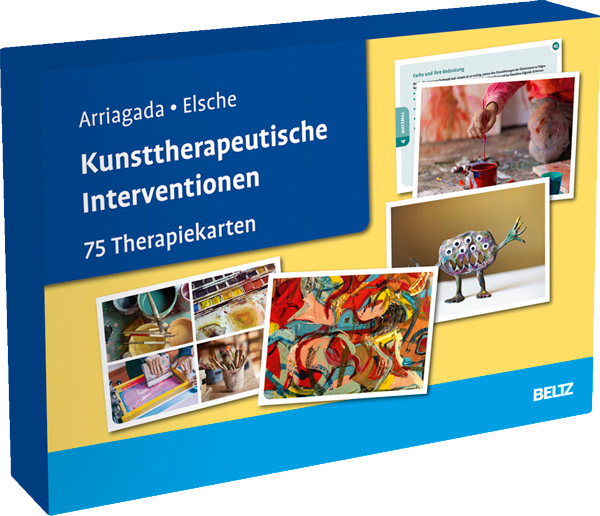Sarah Arriagada co-authored a comprehensive card deck and booklet on art therapy together with Hannah Elsche with the German publisher Beltz. The card deck and booklet Kunsttherapeutische Interventionen, 75 Therapiekarten launched on April 17, 2025 and can be ordered here. Please find below further information about this publication in both German and English.
Kunsttherapeutische Interventionen
75 Therapiekarten mit 28-seitigem Booklet in hochwertiger Klappkassette, Kartenformat 16,5 x 24 cm.
Gemeinsam kreativ werden
- Impulse für die therapeutische Praxis und zur Selbstreflexion
- Leicht umsetzbare Anleitungen
- Einsetzbar in verschiedensten Settings
»Ein Bild sagt mehr als 1000 Worte« – dieses Sprichwort trifft auf kunsttherapeutisches Arbeiten ganz besonders zu. Mit vielfältigen Werkstoffen, Schere, Farbe, Pinsel und Leinwand gemeinsam mit Klient:innen kreativ zu arbeiten kann sichtbar machen, was (noch) nicht in Worte zu fassen ist, und den therapeutischen Prozess voranbringen.
Das Kartenset stellt kompakt und übersichtlich die kunsttherapeutische Praxis dar. Es bietet einen reichen Fundus für angehende wie auch erfahrene Kunsttherapeut:innen sowie für Psychotherapeut:innen, Berater:innen und Coaches sowie für alle Interessierten, die ihre Arbeit mit Wissen und Methoden aus der Kunsttherapie bereichern möchten.
Aus dem Inhalt
Setting • Kunsttherapeutische Ansätze • Einstieg • Material • Beziehungen • Der Künstlerische Prozess und mögliche Stolpersteine • Ethik • Abschied
Erscheinungsdatum: 17.04.2025
Art Therapy Interventions
75 therapy cards with a 28-page booklet in a high-quality folding case; card format 6.5 x 9.4 inches
Get Creative Together
- Prompts for your therapeutic practice and self-reflection
- Easy-to-implement instructions
- Can be used in a variety of settings and with diverse populations
“A picture paints more than a thousand words.” This saying applies particularly to the practice of art therapy. By working creatively using a range of materials, such as scissors, paint, brushes, and canvas, clients are empowered to visualize what cannot (yet) be put into words, and thus advance the therapeutic process.
This card deck presents the practice of art therapy in a streamlined and convenient format. It offers a rich resource for aspiring and experienced art therapists as well as for anyone interested in psychotherapy, counseling and coaching seeking to enrich their work with the knowledge and methods of art therapy.
Excerpt of the Content
Setting • Approaches to Art Therapy • Introduction • Materials • Relationships • The Artistic Process and Possible Stumbling Blocks • Ethics • Endings
On Sale Date: 04/17/2025
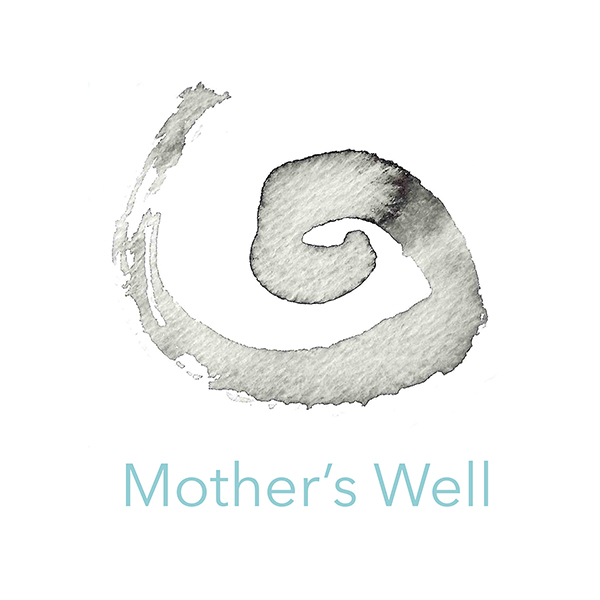
From 2018 to 2019, Mother’s Well offered mothers a confidential and relaxed space for explorative art-making during and after pregnancy. As an art therapist, Sarah facilitated mindful art sessions for groups and individuals.

How can art therapy of be of support during pregnancy and after the birth of a child?
During pregnancy, women undergo drastic changes both on a physical and psychological level as they prepare for birth and motherhood. As they grow a new sense of self, renegotiate roles, relationships, duties, priorities, and dreams at home, work, and in society, they later care 24/7 for an(other) small human being that can shake them up in manifold ways and challenge their resources, beliefs, expectations, and best intentions. How can art therapy be of support in this particularly transformative phase of their life?
Art therapy offers a non-judgmental space in which all feelings and thoughts are allowed to take shape in a contained and safe way. Held by the triangular relationship of the therapist, artwork, and client, new or yet-to-be-defined images of oneself and others can be explored in a confidential and reliable environment. Art-making helps relieve stress and anxiety and to reconnect with inner resources, bringing relaxation and joy.
The American Art Therapy Association explains that “art therapy, facilitated by a professional art therapist, is used to improve cognitive and sensorimotor functions, foster self-esteem and self-awareness, cultivate emotional resilience, promote insight, enhance social skills, [and] reduce and resolve conflicts and distress.”
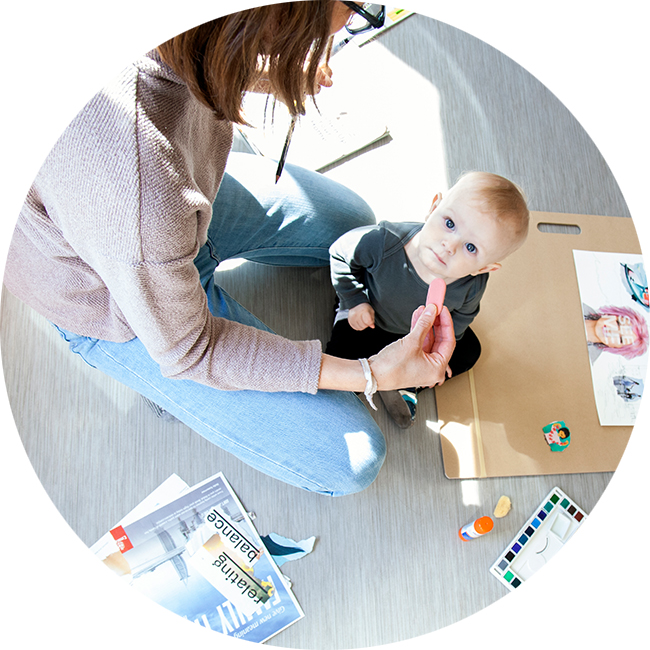
What is the difference between mindful art sessions and art therapy?
Both mindful art and art therapy have healing aspects and serve the wellbeing of the client.
While art therapy, like any other kind of psychotherapy, benefits from the commitment to regular attendance over a specific period of time, mindful art sessions can be booked sporadically.
Mindful art sessions are solution-focussed and directive, which means that the mentor will give prompts and ask questions in order to empower the client to find their own answers and resources in regards to a specific problem.
Art therapy is mainly non-directive which means that although the client and therapist may have agreed on specific goals or areas that need more contemplation, understanding, and integration, the client will decide what materials and subject matter they want to explore in each and every session. Free association and reflection accompany and complete the sessions.
Art therapists are highly qualified and have both broad and specific clinical knowledge. The psychodynamic approach understands the importance of the artwork and that it needs to be kept safe during the time of the therapy. In mindful art sessions, the artwork is usually not revisited.
While there is no contract needed for mindful art sessions, the art therapist and client will agree on a contract for the art therapy. The contract will set guidelines for the therapy, such as attendance, confidentiality, art usage and storage, goals and objectives, and informed consent.
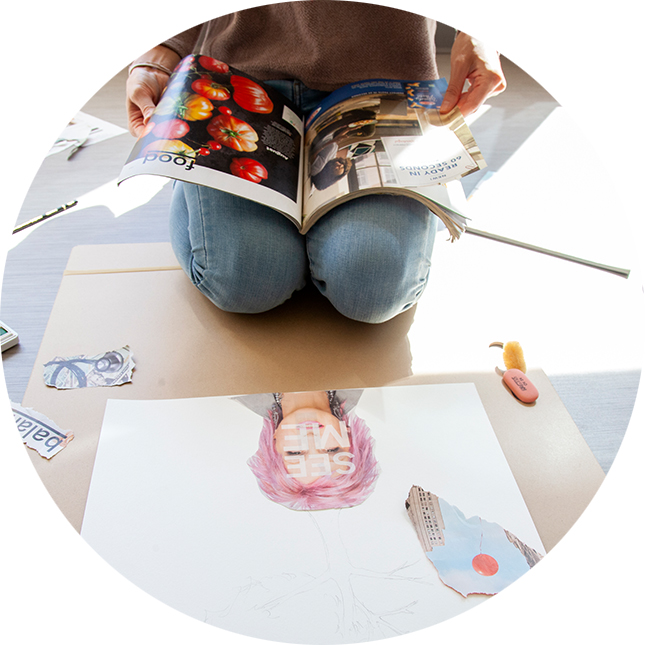
During individual mindful art sessions, your facilitator listens to your thoughts and feelings regarding pregnancy, birth and parenthood and guides you with a solution-focussed mindset through purposeful drawing exercises. Here, you are encouraged to explore the changes in your life, to express and reflect on your emotions as they arise, to find meaning in the questions you may have and to gain strength and calm from the art-making process.
If you feel a little apprehensive about diving into making art, mindful art sessions can offer you a gentle way to get acquainted with the power of the creative process. Your facilitator will offer guidance through themes and prompts and you’ll experience drawing as a tool for exploration and reflection.
Mindful art groups provide participants with the opportunity to witness and support each other’s unique creative expressions and emotional processes. Members quickly reach a deeper level of authenticity and intimacy through the use of the art material and its innate ability to express ambivalent feelings, hidden beliefs and memories as well as new visions, strengths and resources.
Birth story listening sessions may or may not include art-making as a tool of communication, self-discovery and healing. If you struggle with a difficult birth and want to feel differently about your experience, then a birth story listening session may be just what you need. Your facilitator listens to your birth story with a compassionate, mindful and solution-focussed mindset so you can move from confusion and disappointment to transformative emotional healing after birth.
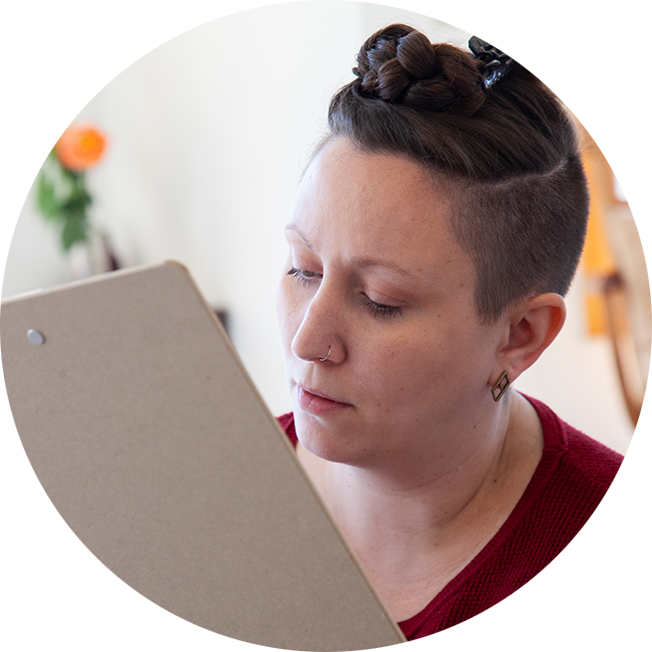
Testimonials
“I am forever grateful for participating in birth art sessions with Sarah while I was pregnant with my son. I don’t consider myself particularly artistic or creative but quickly realized that it didn’t matter. The sessions were fun and enlightening – exactly what I needed to explore my thoughts/feelings on becoming a mother without boundaries or expectations. In discussing my art I was surprised to learn several new things about myself. I know I will continue to reflect on the experience for years to come, as I continue my motherhood journey.”—Lindsay M.
“I really did enjoy the session. I left feeling emotionally lighter than when I went in and have carried that with me. Thank you so much!”—Lacey P.
“Our session really did help me tremendously. I think for me, it was the point of our time together when I switched my thinking, which I had not done before. That instead of remembering and immersing myself in thought patterns of the fear, uncertainty, and lack of preparation for embarking on motherhood (which seemed to be the theme of my whole labor/birth), I have adopted new ways of thinking about the experience. I have felt a lot of healing from transforming my language. By saying, “I brought this child into the world”, which is amazing and such an empowering moment for me. By embracing my role in the process and knowing that I did such a miraculous thing. This transition has completely switched my thoughts of regret or frustration with how the birth went to feeling more content and at peace with the reality of how it went. I have talked about my birth story many, many times, but never in the way I did with you, with a goal and purpose in mind. It really did provide relief in a way that I was not expecting at all. So, thank you so much. I know it will be such a healing and profound experience for other moms that work with you.”—Angela S.
“I do think it has done a lot to have the sessions with Sarah. Sarah is a wonderful listener and I felt witnessed in a powerful way through the process. I feel like my story is integrated in a new way and it has carried over into how I approach the day to day situations where I don’t feel seen or heard. It’s helped me to find my voice and speak up because the work we did together helped me to feel more aware that it is there.”—Lydia T.


